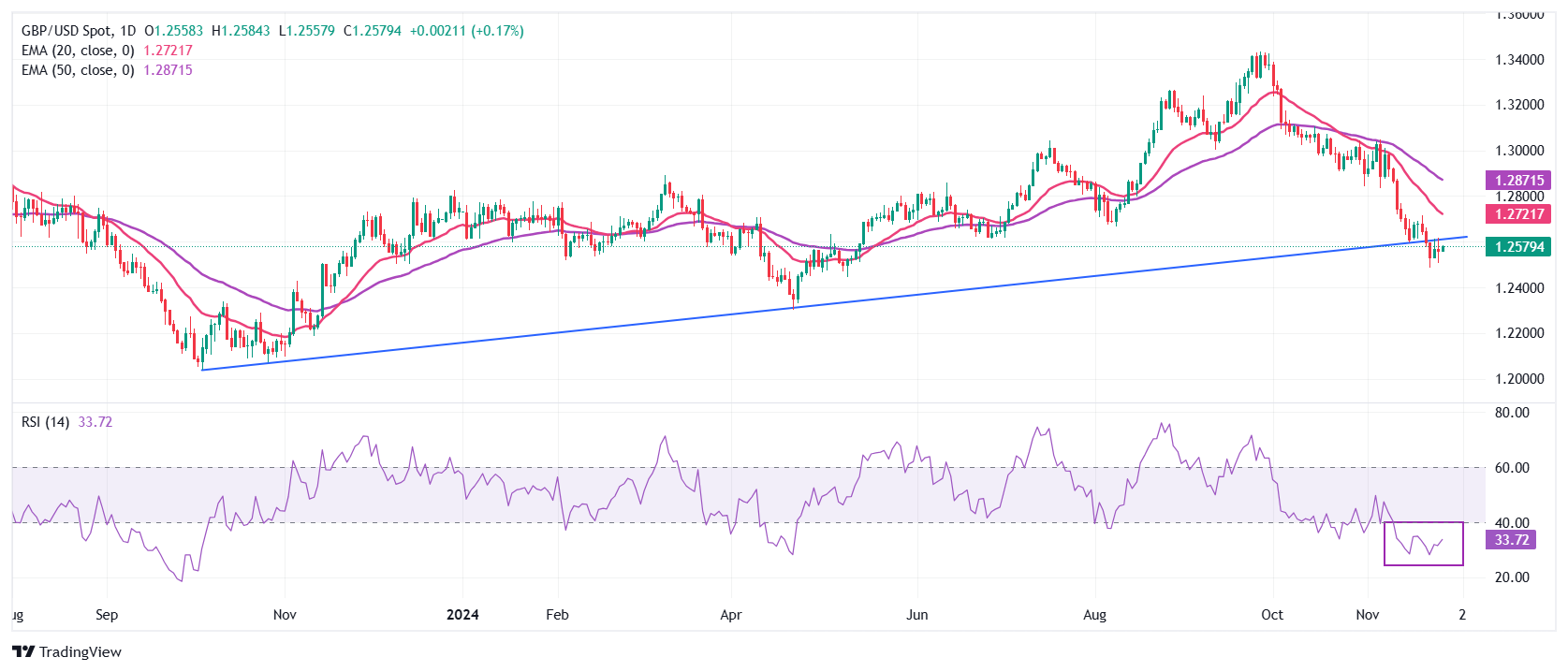- The British Pound consolidates below 1.2600 against the US Dollar as investors await a host of US economic data, including PCE inflation.
- The FOMC minutes offered no meaningful clues about the path of interest rates.
- BoE Lombardelli wants to see evidence of a slowdown in inflation before backing an interest rate cut.
The British Pound (GBP) is trading in a very tight range below 1.2600 against the US Dollar (USD) in the London session on Wednesday. GBP/USD consolidates as US Dollar stays on the sidelines ahead of United States (US) Personal Consumption Expenditure (PCE) Price Index data for October, due at 1pm: 30 GMT.
Economists expect core PCE inflation data, which excludes volatile food and energy prices, to have accelerated to 2.8% from 2.7% in September year-on-year, with monthly figures rising steadily by 0.3%.
Investors will pay close attention to core PCE inflation data as it is the Federal Reserve’s (Fed) preferred inflation measure for making interest rate decisions. Inflation data will influence market expectations about the Fed’s likely action at the December meeting. According to the CME FedWatch tool, the probability that the Fed will cut interest rates by 25 basis points (bps) to 4.25%-4.50% at the December meeting has increased to 65% from 56% a week ago .
Dovish bets on the Fed have escalated following the release of the Federal Open Market Committee (FOMC) minutes for the Nov. 7 policy meeting, although they did not offer any meaningful guidance on the path of interest rates. Some officials suggested that the Fed might consider pausing its rate-cutting cycle if inflation remains “elevated,” while others argued that the policy-easing cycle would need to accelerate if economic conditions or the labor market deteriorate.
In Wednesday’s session, investors will also focus on revised third-quarter gross domestic product (GDP) growth estimates, durable goods orders and personal spending data for October, and initial jobless claims. for the week ending November 22.
So far, the US Dollar Index (DXY) has remained under pressure this week after US President-elect Donald Trump nominated Scott Bessent, an experienced hedge fund manager, to the position of Secretary of the Treasury. Market participants expect Bessent to execute Trump’s stated trade policies strategically and gradually with the intention of avoiding a deadly trade war.
Daily Market Summary: Pound Trades Cautiously Amid US Tariff Concerns
- The British Pound exhibits imprecise price action against its major peers on Wednesday. The British currency is trading cautiously amid growing concerns about the impact of Trump’s tariff policies on the UK’s export sector.
- In an interview with the Financial Times (FT) on Tuesday, Bank of England (BoE) deputy governor Clare Lombardelli said: “US trade tariffs would pose a risk to economic growth.” Lombardelli added: “Trade barriers are certainly negative for growth in the short, medium and long term.” However, he stopped short of forecasting the likely impact of US tariffs on the economy. “Too early to quantify the effects of the proposed tariffs,” Lombardelli said.
- Asked about the BoE’s interest rate cut trajectory, Lombardelli said he wants to see more evidence of easing price pressures to support another interest rate cut. In his speech at King’s Business School on Monday, Lombardelli warned of the risks of inflation remaining higher than the bank’s forecast, with wage growth normalizing at 3.5-4% and the Consumer Prices (CPI) around 3% instead of 2%.
- This week, the UK economic calendar has nothing to offer. Therefore, the British pound will be guided by market expectations for the BoE’s interest rate action at the December meeting. Traders see the BoE leaving interest rates unchanged at 4.75% next month.
Technical Analysis: Sterling falters below 1.2550
The British Pound remains below the ascending trend line near 1.2550 against the US Dollar, which is drawn from the October 2023 low around 1.2040. The GBP/USD outlook remains bearish as the 20-day and 50-day exponential moving averages (EMAs) at 1.2735 and 1.2883, respectively, are tilted lower.
The 14-day Relative Strength Index (RSI) is oscillating within the range of 20.00-40.00, suggesting that the downward momentum is intact.
Looking down, the pair is expected to find support near the May low of 1.2446. To the upside, the November 20 high around 1.2720 will act as key resistance.
The British Pound FAQs
The British Pound (GBP) is the oldest currency in the world (AD 886) and the official currency of the United Kingdom. It is the fourth most traded foreign exchange (FX) unit in the world, accounting for 12% of all transactions, averaging $630 billion a day, according to 2022 data. Its key trading pairs are GBP/ USD, which represents 11% of FX, GBP/JPY (3%) and EUR/GBP (2%). The British Pound is issued by the Bank of England (BoE).
The most important factor influencing the value of the Pound Sterling is the monetary policy decided by the Bank of England. The Bank of England bases its decisions on whether it has achieved its main objective of “price stability” – a constant inflation rate of around 2%. Its main tool to achieve this is the adjustment of interest rates. When inflation is too high, the Bank of England will try to control it by raising interest rates, making it more expensive for people and businesses to access credit. This is generally positive for sterling, as higher interest rates make the UK a more attractive place for global investors to invest their money. When inflation falls too much it is a sign that economic growth is slowing. In this scenario, the Bank of England will consider lowering interest rates to make credit cheaper, so that companies will take on more debt to invest in projects that generate growth.
The data released measures the health of the economy and may affect the value of the pound. Indicators such as GDP, manufacturing and services PMIs and employment can influence the direction of the Pound.
Another important data that is published and affects the British Pound is the trade balance. This indicator measures the difference between what a country earns from its exports and what it spends on imports during a given period. If a country produces highly in-demand export products, its currency will benefit exclusively from the additional demand created by foreign buyers seeking to purchase those goods. Therefore, a positive net trade balance strengthens a currency and vice versa in the case of a negative balance.
Source: Fx Street
I am Joshua Winder, a senior-level journalist and editor at World Stock Market. I specialize in covering news related to the stock market and economic trends. With more than 8 years of experience in this field, I have become an expert in financial reporting.








